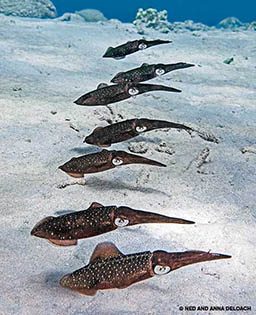As I sink beneath its surface, the blue water of Bonaire seeps into my sun-baked wetsuit like a salve. I cut across a sand shelf and head toward open sea. I’m on my way to visit 11 new friends who have made a habit of hanging out near a set of abandoned, concrete-filled mooring barrels not far from where the reef slope begins. For a week now, from first light ’til last, the shoal of 11 Caribbean reef squid has been in the area, hovering just a few feet above the bottom in a linear formation.
As usual, the group retreats at my approach. No worries; they’ll be back. After eight dives with this bunch two facts stand out: Foremost, squid can’t be too cautious — many large carnivores, including humans, love calamari. On average the shoal will be attacked four times every hour, most often by fast-moving jacks or sly barracudas. Fact two: Squid, along with their cephalopod cousins cuttlefish and octopus, are the most intelligent invertebrates on Earth and are endlessly curious. I’m too much of a novelty for them to resist. All I have to do is kneel in the sand near where they were and wait.
Within minutes the shoal returns, swimming forward with their 22 big, silvery eyes locked on me. Three or four approach close, staring into my face mask and circling above my head before falling back into the long, lazy line with larger members stationed at each end as sentinels. It is rare to be so close to any wild animal, especially creatures as exotic as squid. Even during long periods when there is little happening I’m content to be in their company, simply watching them watch me.

In addition to brainpower, natural selection has endowed squid with a bagful of nifty adaptations. They are well known for their ability to change body colors and patterns to blend into the background; but even more impressively, they use their overlapping layers of specialized skin cells, known as chromatophores, to flash an assortment of messages to shoalmates throughout the day. Such wizardry is only the beginning. Besides being able to maneuver forward or backward and turn on a dime, squid can force water through their siphons with such power that they can disappear in a blink. If necessary, they expel smoke screens of ink to conceal their escape or mix mucus with the ejected brew to create stringy clouds of diversions, known as pseudomorphs.
But not all is tedium or terror in squidland: During lulls between attacks, larger members find time to get frisky. And that’s what I’m really here for: squid sex — where chromatophoric art plays a pivotal role in sorting out how the shoal’s genetics will be shuffled. Courtship begins with a pair of males and a lone female breaking away from the group, zipping around and flashing signals. The males steal the show, repeatedly sailing close together with their arms splayed in a dazzling zebra pattern. Researchers are uncertain about how exactly this dramatic ritual settles matters, but one of the competitors eventually wins the right to mate and immediately directs his attention toward the female.
It takes a bit of swimming to keep up with the chasing pair. I want to be close when the female eventually slows, allowing the male to slip alongside. Pulsing bright like a disco light, he slaps a packet of sperm into her arms. Moments later I follow as the pair weave their way down the reef and head for a secluded location where the female has been stashing finger-size egg capsules for a week.

That’s when I meet up with Anna, who has long wanted to document egg-laying squid on video. We hang back at a distance and watch the female rock back and forth with her long sucker-lined arms extended toward a narrow crevice when suddenly the reef explodes in a whirl of black. All I remember of the uproar is a flash of terrifying teeth that disappear back inside the inky mass. In an instant it is all over. No attacker, no squid, no panic — it’s as if nothing happened. I glance over at Anna; her eye is still welded to the viewfinder, closely following two pseudomorphs as they lazily float out of the dispersing ink cloud.
Back at the room Anna, still damp from the dive, downloads her video. The sequence begins with a blur the size of a softball bat streaking in from behind. Slow motion saves the day. Frame by frame the images capture the female squid releasing a smoke screen less than a quarter of a second (eight frames) before a giant lizardfish disappears inside the blinding morass. Near the top, a dark plume traces what appears to be her escape.
We’re up early the following morning heading back to the mooring before breakfast. We count the shoal. There are 11 squid — including the large female, hovering at the end of the line with the tiniest of tears near the rear of her calmly fluttering fin.
© Alert Diver — Q1 Winter 2015